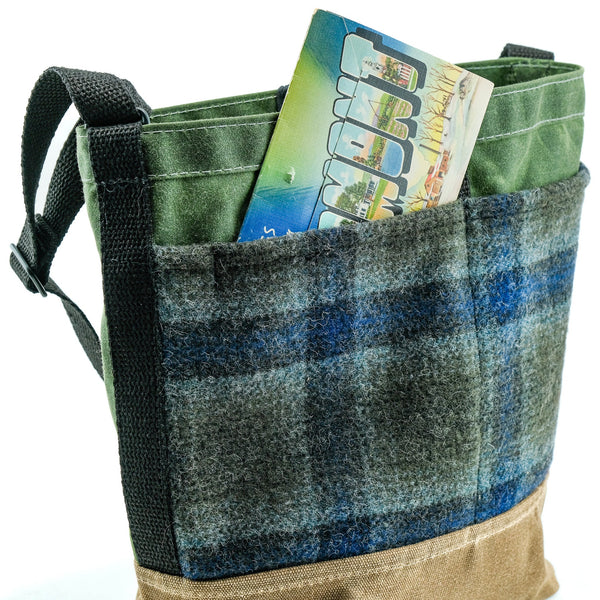What is Fifth Season Canvas?

Fifth Season Canvas was created to champion the best materials that exist for eco friendly bag building: Waxed Canvas, Hemp, Leather and Brass. Our bags and products are made by one gal in Middlebury Vermont. They're designed to last for years. They’re not flashy, they’re not trendy, but they are the future of sustainable bag design.
Why do all bag brands rely on ‘new’ tech that so obviously has a short shelf life? Nylon and X-Pac and Cordura might be short term ‘tough’ but they can’t handle being out in the sun, freeze-thaw cycles or the simple passing of time. Plastic buckles break. Zippers get jammed, fail or loose their temporary waterproofery.
Many nylon fabrics are only temporarily ‘waterproof’ because of a factory DWR finish. Guess what DWR is made of? Teflon. So you are out cruising around with this nylon DWR coated whatever, and as that stuff washes out, it’s heading straight to your local lake, stream, river, ocean. Teflon doesn’t belong in the water, it’s hyper dangerous to the environment. You wanna drink something called a polytetrafluoroethylene? Yeah, neither do fish or birds or cows. But we keep putting this stuff on outdoor gear, and pretending like it’s ok. It’s not. You know who invented Cordura and the base materials used in X-pac? The same assholes who invented Teflon.
Nylon production, which is the base of Cordura fabrics, produces Nitrious Oxide, a green house gas 300 times more potent than CO2. Technically nylon can be recycled, but good luck finding a company that does it. It’s not like you can just dump it in your recycling bin. If you just toss it, it’s gunna degrade in 40-60 years if it's properly composted. That means not thrown in a landfill. Polyester, the base of Xpac, puts "antimony, cobalt, manganese salts, sodium bromide and titanium dioxide into the environment." Polyester can take up to 400 years to degrade.
If King James IV (the guy who commisioned the King James Bible in the 1600's) had a polyester bag he tossed out in 1620, it would just now have fully decomposed. "When washed, fibres from polyester textiles and clothing are shed and enter waterways and oceans as microplastic fibres, according to the most recent studies. Fish, shellfish and other aquatic creatures ingest the microplastics, which accumulate, concentrating toxins up the food chain. These can enter human food chains and pass into the wider environment." This is not what you want out of a product meant to help you enjoy life outdoors.
Sustainable things last & stay useable for a long time. They’re made in a way that is as friendly as possible to the earth. Everyone produces unsustainable waste. The best thing we can do is cut it to the bare minimum. Fifth Season Canvas is the future (and oddly the distant past) of bike bag fabrication. We enchew plastics . No plastic buckles. No teflon. Here’s the ingredient list: Canvas, leather, brass, hemp webbing, canvas wax (made of beeswax and paraffin, which is made from an oil production waste product called Slack Oil. Paraffin is a food safe wax, and you have almost certainly eaten paraffin many a time when snacking on an apple, hard candy, chocolate, veggies and cured sausages. Contrast this with Teflon…)
You can rewax canvas, but you can’t relaminate delam’d X-Pac. And it will delam. Just give it a bit of time. Canvas is easy to repair with a basic needle and thread. If you pop a rivet, you can either re-rivet it yourself with a cheap rivet kit or take it to a cobbler who will charge you 12 bucks and send you on your way. Canvas bags routinely last decades, and just need an occasional rewaxing, which you can do at home on a sunny hot day or with your oven or hair dryer. Brass clasps are strong, super long lasting and ultimately can be taken to the scrap metal recycler. Canvas and leather can go right in the compost pile after a hard and long life.
Good bags are simple, durable, repairable, long lasting and elegant. The best bags are made by people who care about what they’re doing.

